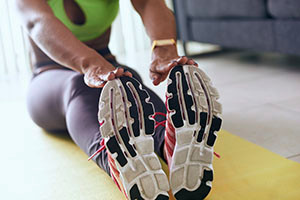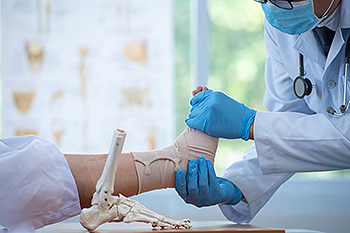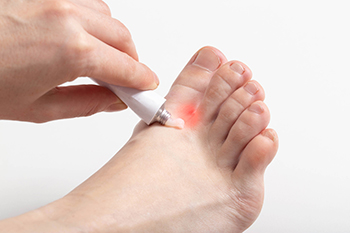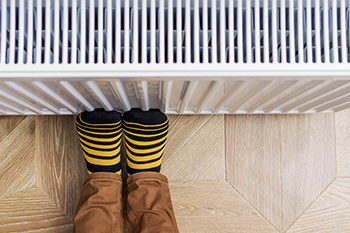Items filtered by date: February 2022
Dos and Don’ts of Exercising With Plantar Fasciitis
 If you suffer from plantar fasciitis, you may have heard that performing certain exercises can help alleviate pain and speed up your recovery. There are a variety of stretches that you can do to help with plantar fasciitis. One of the easiest stretches is flexing your foot up and down 10 times prior to standing after a long period of rest (when plantar fasciitis pain is at its worst). There are also certain exercises that you should avoid. These include any jumping activities and any high impact exercises, such as running. If you are suffering from plantar fasciitis, please seek the care of a podiatrist.
If you suffer from plantar fasciitis, you may have heard that performing certain exercises can help alleviate pain and speed up your recovery. There are a variety of stretches that you can do to help with plantar fasciitis. One of the easiest stretches is flexing your foot up and down 10 times prior to standing after a long period of rest (when plantar fasciitis pain is at its worst). There are also certain exercises that you should avoid. These include any jumping activities and any high impact exercises, such as running. If you are suffering from plantar fasciitis, please seek the care of a podiatrist.
Plantar fasciitis can be very painful and inconvenient. If you are experiencing heel pain or symptoms of plantar fasciitis, contact Donald Manger, DPM from Associated Podiatric Physicians, PA. Our doctor can provide the care you need to keep you pain-free and on your feet.
What Is Plantar Fasciitis?
Plantar fasciitis is the inflammation of the thick band of tissue that runs along the bottom of your foot, known as the plantar fascia, and causes mild to severe heel pain.
What Causes Plantar Fasciitis?
- Excessive running
- Non-supportive shoes
- Overpronation
- Repeated stretching and tearing of the plantar fascia
How Can It Be Treated?
- Conservative measures – anti-inflammatories, ice packs, stretching exercises, physical therapy, orthotic devices
- Shockwave therapy – sound waves are sent to the affected area to facilitate healing and are usually used for chronic cases of plantar fasciitis
- Surgery – usually only used as a last resort when all else fails. The plantar fascia can be surgically detached from the heel
While very treatable, plantar fasciitis is definitely not something that should be ignored. Especially in severe cases, speaking to your doctor right away is highly recommended to avoid complications and severe heel pain. Your podiatrist can work with you to provide the appropriate treatment options tailored to your condition.
If you have any questions please feel free to contact our office located in Hamilton Township, NJ . We offer the newest diagnostic and treatment technologies for all your foot and ankle needs.
Reminder: When Was the Last Time...?
Revealing the Menacing Characteristics of Athlete’s Foot
Tinea pedis (athlete’s foot) is a very contagious, even sneaky, fungus. It can travel from an infected person’s foot onto a locker room floor, public shower or swimming pool area, and linger until it comes in contact with an unsuspecting pair of bare feet. Athlete’s foot can also transfer directly from person to person, or through contact with contaminated socks, towels and shoes. That is why it is very important to wear flip-flops in warm, moist communal areas and never share personal items with others. Tinea pedis loves to live in the dark, moist webbing between toes, causing a very itchy, scaly rash that can spread to other parts of the feet. These symptoms are often exacerbated by wearing tight shoes or sweaty socks for an extended period of time. A certain form of athlete’s foot can even produce painful blisters on the sole of the feet. As uncomfortable and itchy as these symptoms are, it is important to refrain from scratching, as the infection can spread to the hands and possibly lead to a bacterial infection. In some cases, this nasty infection will attack the toenails, causing them to thicken, crumble, become discolored and disintegrate. If your feet have been attacked by tinea pedis, it’s a good idea to seek the professional care of a podiatrist. They will provide prompt relief and help avoid the condition from worsening.
Athlete’s Foot
Athlete’s foot is often an uncomfortable condition to experience. Thankfully, podiatrists specialize in treating athlete’s foot and offer the best treatment options. If you have any questions about athlete’s foot, consult with Donald Manger, DPM from Associated Podiatric Physicians, PA. Our doctor will assess your condition and provide you with quality treatment.
What Is Athlete’s Foot?
Tinea pedis, more commonly known as athlete’s foot, is a non-serious and common fungal infection of the foot. Athlete’s foot is contagious and can be contracted by touching someone who has it or infected surfaces. The most common places contaminated by it are public showers, locker rooms, and swimming pools. Once contracted, it grows on feet that are left inside moist, dark, and warm shoes and socks.
Prevention
The most effective ways to prevent athlete’s foot include:
- Thoroughly washing and drying feet
- Avoid going barefoot in locker rooms and public showers
- Using shower shoes in public showers
- Wearing socks that allow the feet to breathe
- Changing socks and shoes frequently if you sweat a lot
Symptoms
Athlete’s foot initially occurs as a rash between the toes. However, if left undiagnosed, it can spread to the sides and bottom of the feet, toenails, and if touched by hand, the hands themselves. Symptoms include:
- Redness
- Burning
- Itching
- Scaly and peeling skin
Diagnosis and Treatment
Diagnosis is quick and easy. Skin samples will be taken and either viewed under a microscope or sent to a lab for testing. Sometimes, a podiatrist can diagnose it based on simply looking at it. Once confirmed, treatment options include oral and topical antifungal medications.
If you have any questions, please feel free to contact our office located in Hamilton Township, NJ . We offer the newest diagnostic and treatment technologies for all your foot care needs.
Top 4 Conditions That Cause Cold Feet
If your feet always feel cold, it may be due to one of the following four reasons. 1) You may have poor circulation. Feet need a steady flow of blood to keep them warm. Poor circulation causes blood vessels to constrict which limits the amount of blood traveling to the feet. 2) You may have Raynaud’s syndrome. This is a condition where blood vessels that supply the skin with blood constrict and spasm temporarily, thereby limiting blood flow. This may even cause your skin to change colors temporarily as blood flow is cut off and then returns. 3) You may be overly stressed or anxious. The body’s reaction to extreme stress or anxiety may trigger a “fight or flight” response which can direct blood flow towards larger organs—which are more critical to survival—and away from the extremities. 4) You may have anemia, which is an insufficient amount of red blood cells. Anemia reduces the amount of oxygen in the blood, sometimes causing cold feet. If you are concerned about your feet always feeling cold, contact a podiatrist to determine what the underlying cause may be and to get the appropriate treatment.
While poor circulation itself isn’t a condition; it is a symptom of another underlying health condition you may have. If you have any concerns with poor circulation in your feet contact Donald Manger, DPM of Associated Podiatric Physicians, PA. Our doctor will treat your foot and ankle needs.
Poor Circulation in the Feet
Peripheral artery disease (PAD) can potentially lead to poor circulation in the lower extremities. PAD is a condition that causes the blood vessels and arteries to narrow. In a linked condition called atherosclerosis, the arteries stiffen up due to a buildup of plaque in the arteries and blood vessels. These two conditions can cause a decrease in the amount of blood that flows to your extremities, therefore resulting in pain.
Symptoms
Some of the most common symptoms of poor circulation are:
- Numbness
- Tingling
- Throbbing or stinging pain in limbs
- Pain
- Muscle Cramps
Treatment for poor circulation often depends on the underlying condition that causes it. Methods for treatment may include insulin for diabetes, special exercise programs, surgery for varicose veins, or compression socks for swollen legs.
As always, see a podiatrist as he or she will assist in finding a regimen that suits you. A podiatrist can also prescribe you any needed medication.
If you have any questions, please feel free to contact our office located in Hamilton Township, NJ . We offer the newest diagnostic and treatment technologies for all your foot care needs.
How to Know if You Should Visit a Podiatrist
 There are a variety of issues and injuries that can result in pain, swelling or stiffness to the feet and ankles, including trauma or just simple wear and tear on the body. While staying active is the best way to help keep your feet in shape, there are signs to look for that may indicate the care of a podiatrist is necessary. Anyone who has experienced significant trauma to a foot or ankle from a fall or direct injury would be wise to have the injured area examined by a professional as soon as possible. Further, if you notice that your feet or ankles are misshapen, have a hot or tender feeling, constantly hurt, or are unable to bear weight, it is suggested that you consult a podiatrist to find the source of the issue. Once a diagnosis is made, a podiatrist will be able to help provide a proper treatment plan.
There are a variety of issues and injuries that can result in pain, swelling or stiffness to the feet and ankles, including trauma or just simple wear and tear on the body. While staying active is the best way to help keep your feet in shape, there are signs to look for that may indicate the care of a podiatrist is necessary. Anyone who has experienced significant trauma to a foot or ankle from a fall or direct injury would be wise to have the injured area examined by a professional as soon as possible. Further, if you notice that your feet or ankles are misshapen, have a hot or tender feeling, constantly hurt, or are unable to bear weight, it is suggested that you consult a podiatrist to find the source of the issue. Once a diagnosis is made, a podiatrist will be able to help provide a proper treatment plan.
Foot and ankle trauma is common among athletes and the elderly. If you have concerns that you may have experienced trauma to the foot and ankle, consult with Donald Manger, DPM from Associated Podiatric Physicians, PA. Our doctor will assess your condition and provide you with quality foot and ankle treatment.
Foot and ankle trauma cover a range of injuries all over the foot; common injuries include:
- Broken bones
- Muscle strains
- Injuries to the tendons and ligaments
- Stress fractures
Symptoms
Symptoms of foot and ankle injuries vary depending on the injury, but more common ones include:
- Bruising
- Inflammation/ Swelling
- Pain
Diagnosis
To properly diagnose the exact type of injury, podiatrists will conduct a number of different tests. Some of these include sensation and visual tests, X-rays, and MRIs. Medical and family histories will also be taken into account.
Treatment
Once the injury has been diagnosed, the podiatrist can than offer the best treatment options for you. In less severe cases, rest and keeping pressure off the foot may be all that’s necessary. Orthotics, such as a specially made shoes, or immobilization devices, like splints or casts, may be deemed necessary. Finally, if the injury is severe enough, surgery may be necessary.
If you have any questions, please feel free to contact our office located in Hamilton Township, NJ . We offer the newest diagnostic and treatment technologies for all your foot care needs.



